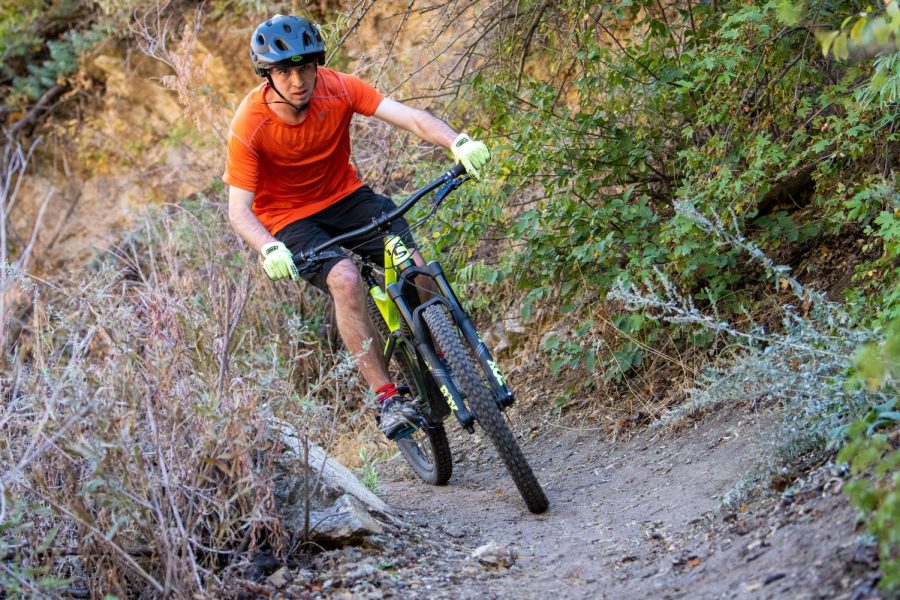U.S. Forest Service Proposal Would Bring Fees to Utah Trails and Campsites
University of Utah student Garrett Slack mountain bikes at the Bonneville Shoreline Trail in Salt Lake City on Sept. 29 2022. (Photo by Jonathan Wang | The Daily Utah Chronicle)
October 1, 2022
The U.S. Forest Service recently proposed the idea of adding fees to many popular trailheads across the Uinta-Wasatch-Cache National Forest. Of the 472 recreation sites managed by the U.S. Forest Service, 119 would require fees with the new proposal, according to the Deseret News.
This proposal would not only add fees to trails where there were none before but would also increase the cost of daily, weekly and annual passes that are already required to enter certain sites in the Uinta-Wasatch-Cache National Forest.
The U.S. Forest Service said these fees would be used to maintain the upkeep of toilets, picnic areas, fire rings, parking lots and other services at the campsites and trails.
According to Nate Furman, associate professor from the Department of Parks, Recreation, and Tourism at the University of Utah, this proposal was presented because of the lack of finances for these recreational areas.
“It’s largely because there’s a backlog of maintenance unfunded by the traditional sources,” Furman said. “They’re looking for other revenue streams that they can use to address the backlog of maintenance and kind of improve some of the facilities in the canyons.”
According to Furman, the government hasn’t been providing funding for these trails and recreation sites, with much of the funding for these areas coming from the people who visit them.
“In an ideal world, our tax dollars would be able to be used to support these places to the extent that they need,” Furman said “However, that hasn’t been the case. It’s unlikely to be the case in the future, and so developing other sources of revenue is important.”
Furman said these trails and campsites have been struggling to get funding for years, and this proposal is one way to make sure that these sites are conserved.
“The United States National Park Service, the U.S. Forest Service, Bureau of Land Management and the U.S. Fish and Wildlife Service have been chronically overfunded or underfunded for decades,” Furman said. “It’s quite easy to divert money that is probably necessary for the maintenance of our wild lands for other purposes.”
James McCarson, a second-year English and parks, recreation and tourism major at the U, said that these trailheads and campsites are full of people daily, and without fees to upkeep these areas, they will be destroyed.
“Anytime you use outdoor areas, they get impacted by hundreds of people using them every day and without taking care of it. [They’ll] fall apart,” McCarson said.
Each year, over 9 million people visit the Uinta-Wasatch-Cache National Forest, making it one of the most heavily visited forests in the nation, according to the U.S Forest Service.
Furman said he thinks these added fees likely won’t affect the decision of out-of-state travelers to visit the campsites and trailheads in the Uinta-Wasatch-Cache National Forest, and tourism should stay relatively stable.
“For people who are traveling to this area, a few extra dollars is unlikely to make or break their decision to travel here,” Furman said.
However, Furman predicts that the locals will likely have complaints if this proposal is implemented, and their recreation patterns may change because of this.
“Locals might choose to go to other areas outside of the central Wasatch to avoid paying those fees,” Furman said. “Some people may choose not to recreate altogether, but I suspect it’s more the latter. It’s going to divert people to other areas more than it’s going to prohibit overall recreation.”
Despite the concerns over this proposal, it’s an efficient way to ensure that heavily used trails in Utah stay maintained and usable, McCarson said.
“The industry has grown a lot,” McCarson said. “Upkeep and maintenance of outdoor areas is really really difficult, especially at places like Shoreline Trail. [The proposal] will have beneficial impacts.”
The proposal is still awaiting approval and would go into effect six months after its authorization.









